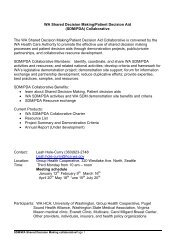Ohio Health Quality Improvement Plan
Ohio Health Quality Improvement Plan
Ohio Health Quality Improvement Plan
Create successful ePaper yourself
Turn your PDF publications into a flip-book with our unique Google optimized e-Paper software.
Appendix I— Statewide EffortsBelow is a list of examples (not meant to be exhaustive) of prominent statewide efforts to improve health quality in <strong>Ohio</strong>.<strong>Health</strong>y <strong>Ohio</strong><strong>Health</strong>y <strong>Ohio</strong>, a Governor’s initiative located at the <strong>Ohio</strong>Department of <strong>Health</strong>, provides and supports programsand activities promoting health and prevention of chronicdisease and injury. The program’s goals are to assure ahealthy, productive workforce, equip students for learning,and create a better quality of life while also contributingto the more efficient and cost-effective use of medicalservices.Program initiatives include the prevention and reductionof obesity, chronic disease prevention (including theBreast and Cervical Cancer Program and others addressingdiabetes, heart disease and stroke, and comprehensivecancer), injury prevention (including the child passengersafety program), and sexual assault and domestic violenceprevention. In addition, <strong>Health</strong>y <strong>Ohio</strong> encompasses thecomprehensive Tobacco Use Prevention and CessationProgram. <strong>Health</strong>y <strong>Ohio</strong> also works with sister agenciesto enhance, develop, and coordinate health promotionand disease prevention programs, especially for targetpopulations such as seniors, those with low-incomes, orthose with mental health and/or substance abuse issues.The Office of <strong>Health</strong>y <strong>Ohio</strong> includes a dedicated<strong>Health</strong> Equity Coordinator charged with improving theDepartment’s and state’s identification and improvement ofhealth disparities, whether associated with race, ethnicity,gender, geography, or income.<strong>Ohio</strong> Patient Safety InstituteThe <strong>Ohio</strong> Patient Safety Institute (OPSI) is an organizationdedicated to improving patient safety in <strong>Ohio</strong>. The Instituteis a subsidiary of the <strong>Ohio</strong> <strong>Health</strong> Council, which wasfounded by the <strong>Ohio</strong> Hospital Association, the <strong>Ohio</strong>State Medical Association, and the <strong>Ohio</strong> OsteopathicAssociation. Through this collaboration and common effort,OPSI has the ability to work with more than 180 hospitalsand 9,000 physicians in <strong>Ohio</strong> to improve patient safety forall <strong>Ohio</strong>ans.Representative work undertaken by OPSI includesinitiatives in medication safety, surgery and anesthesiasafety, standardized hospital wristbands for patients,fall prevention, and reducing methicillin-resistantStaphylococcus aureus (MRSA) transmission and infection.In 2009, the Agency for <strong>Health</strong> care Research and <strong>Quality</strong>(AHRQ) designated OPSI as a Patient Safety Organization.OPSI is the first organization in <strong>Ohio</strong> to receive the federaldesignation and one of 46 in the U.S. to date.<strong>Ohio</strong> Business Roundtable <strong>Health</strong>InitiativesIn addition to its overall health care reform advocacy, the<strong>Ohio</strong> Business Roundtable has three initiatives underway inwhich it has a direct leadership role:1. An employer-led actions initiative aimed at catalyzingadoption of employer best practices to improve health,reduce cost, and increase access across 18 priorityreform areas identified in the BRT’s recent diagnosticreport, Improving <strong>Ohio</strong>’s <strong>Health</strong> System.2. A child obesity initiative that, in addition to developing3.long-term population health improvement strategies,focuses on improving nutrition, physical activity, andphysical fitness reporting standards in schoolsSolutions for Patient Safety, a partnership between theCardinal <strong>Health</strong> Foundation, OHA, OCHA, severalparticipating hospitals, and other organizations thataims to reduce preventable health care associatedinfections and avoidable medication errors.The BRT’s health care report may be accessed by visitingwww.BRT<strong>Health</strong>Report.com.Unified Long-term Care BudgetThe Unified Long-term Care Budget is a flexible fundingprocess that provides long-term care services and supportsbased on consumer choice and need; helps to contain stateand federal Medicaid costs; and includes both nursingfacilities and home- and community-based settings.The Unified Long-term care Budget would eventuallyserve all consumers with chronic or recurring needs forservices, regardless of age or disability. Several of therecommendations made by the Unified Long-term CareBudget Workgroup support enhanced care management andeasing the transition from acute care to long-term care.26










